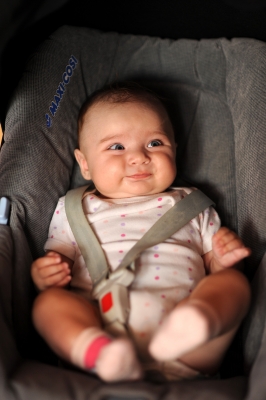Did you know that motor vehicle injuries are the leading cause of death among children in the United States? Although a frightening fact, it is one that we can work together to change. According to the Centers for Disease Control and Prevention (CDC), we can reduce serious and fatal injuries among children by more than half by placing them in age- and size- appropriate car seats and booster seats.
Considering this dramatic impact, it’s more important than ever to use car seats to protect your children in case of a motor vehicle accident, yet a 2010 CDC study revealed that in one year, more than 618,000 kids ages 0-12 rode in vehicles without the use of a booster or child safety seat at least some of the time.
Owning a car seat is a step in the right direction, but do you know how to properly use it? A CDC study found that 72 percent of nearly 3,500 observed booster and car seats were misused. In fact, these car seats were misused in a way that could increase the child’s risk of injury during a car crash, so it’s crucial to understand how to use a car seat properly to protect your child.
♦ In one year, more than 618,000 children ages 0-12 rode in vehicles without the use of a car seat ♦
Review the following child car seat safety tips to ensure that you have the proper car seat and knowledge needed to protect your child in case of a car accident:
 Use a rear-facing car seat when traveling with an infant in the car. Ideally, infants should remain in rear-facing car seats until they reach the age of 2 or exceed the seat’s height and weight limits.
Use a rear-facing car seat when traveling with an infant in the car. Ideally, infants should remain in rear-facing car seats until they reach the age of 2 or exceed the seat’s height and weight limits.- Children who have outgrown the rear-facing car seats should be moved into front-facing seats, remaining in these seats until the age of 4 or until the seat no longer fits. If children have exceed the seat’s height and weight limit, their shoulders are above the seat’s top harness slots, or their ears are above the top of the car seat, you can be sure that the seat no longer fits.
- Once children outgrow front-facing car seats, they should be placed in booster seats until they are big enough for seat belts to fit them properly. You can tell that a seat belt fits correctly when the lap belt lies across the child’s upper thighs and the shoulder belt crosses over the child’s shoulder and chest. Typically, this occurs between 8 and 12 years old, when you child reaches a height of 4’9,” but every child is different.
- As parents, you should use a seat belt at all times to set a good example for your child. Nearly 40 percent of children who ride with unbelted drivers aren’t buckled in either, according to the CDC.
- Make sure the child safety seat is less than 10 years old and in excellent condition. Use the detailed instruction booklet to ensure that the car seat isn’t missing any parts, and check for damage like cracked plastic, frayed straps and stiff buckles.
- Stay up to date on CPSC product recalls. A child car seat can be recalled because of a defect that could compromise your child’s safety. Since manufacturers are required to fix the problem free of charge, be sure to get your car seat fixed immediately if affected by a recall.
- Never let your child ride without a car seat because of a recall. While you should always try to get a recalled safety seat fixed as soon as possible, it’s safer to keep your child in the recalled safety seat than to allow him/her to ride using only a safety belt.
At Eaton & Berube Insurance Agency, your safety is our top priority. For additional safety tips and information, please subscribe to our blog or contact us.
